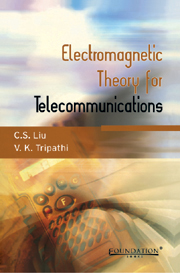Book contents
- Frontmatter
- Contents
- Preface
- 1 Electromagnetic Fields
- 2 Plane Waves
- 3 Guided Waves
- 4 Radiation
- 5 Radio Communication and Radar
- 6 Satellite Communication
- 7 Laser and Optical Fibre Communication
- 8 Geological Seisming and Remote Sensing
- 9 Relativistic Covariance of Electrodynamics
- 10 Radiation from Accelerated Charges
- Appendix A
- Appendix B
- Index
3 - Guided Waves
Published online by Cambridge University Press: 26 October 2011
- Frontmatter
- Contents
- Preface
- 1 Electromagnetic Fields
- 2 Plane Waves
- 3 Guided Waves
- 4 Radiation
- 5 Radio Communication and Radar
- 6 Satellite Communication
- 7 Laser and Optical Fibre Communication
- 8 Geological Seisming and Remote Sensing
- 9 Relativistic Covariance of Electrodynamics
- 10 Radiation from Accelerated Charges
- Appendix A
- Appendix B
- Index
Summary
Introduction
Point-to-point communication and numerous other applications require electromagnetic waves to remain localised in the transverse direction, as they propagate. However, waves of finite transverse size suffer diffraction divergence. They also suffer scattering losses due to particles, refractive index irregularities and other obstacles in their path. Such losses can be overcome by guiding the waves through coaxial cables, metallic pipes, glass fibres and planar guiding systems. The guiding systems have other advantages too. For instance, wave guides loaded with slow wave structures can reduce the phase velocity of microwaves much below the velocity of light in vacuum, facilitating the amplification of these waves by electron beams (via Cerenkov interaction) in travelling wave tubes. Guided slow waves, under suitable conditions, can be used to accelerate electrons to ultra-relativistic energies as in a linear accelerator (LINAC). Microwave and optical passive devices like directional couplers, circulators, attenuators, etc. too involve guided propagation.
In this unit, we study guided propagation of electromagnetic waves through various kinds of guiding systems. We begin with the surface plasma wave (SPW), that is guided along the interface between a conductor and a dielectric. Then, we study the propagation of waves through parallel plane guiding system, rectangular waveguide, cylindrical waveguide, sheath helix, rippled wall guiding systems and coaxial cable. The propagation through optical fibres is taken up separately in the chapter on optical communication.
- Type
- Chapter
- Information
- Electromagnetic Theory for Telecommunications , pp. 106 - 151Publisher: Foundation BooksPrint publication year: 2007



